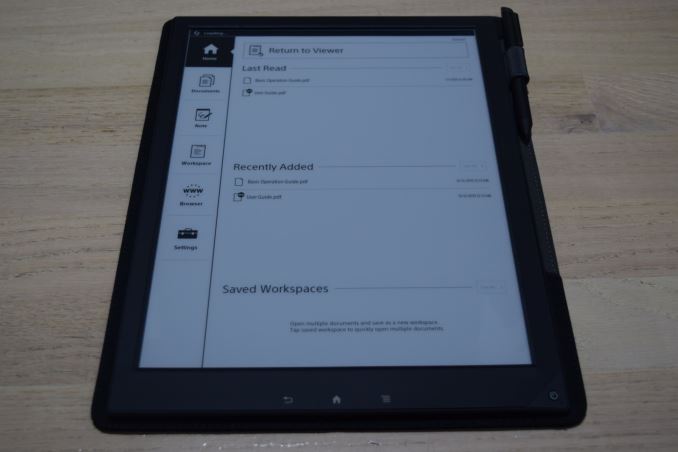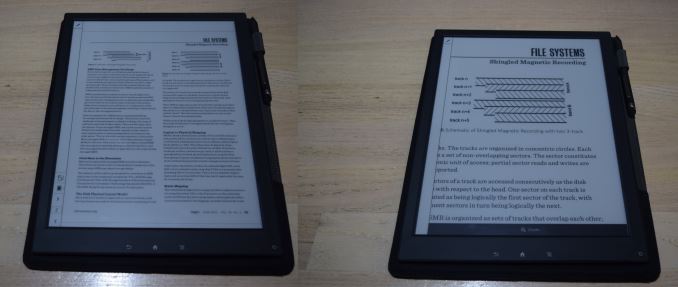Sony Digital Paper System DPT-S1 Review
by Ganesh T S on December 17, 2015 8:50 AM ESTSoftware and UI Aspects
The Sony DPT-S1 runs a Linux kernel, but the user interface shows no signs of Linux running under the hood. The setup process is quite straightforward - the time zone, date, pen grip style and an user name are the minimum required things to get started with the unit.
The main screen is organized in two panes. The smaller-width left pane provides the main options - a 'Home' view, 'Documents', 'Note', 'Workspace', 'Web Browser' and 'Settings'.
The 'Documents' section allows users to explore the file system (local storage as well as network drives) for PDFs. The 'Note' section allows for creation of handwritten notes (they are saved as PDFs).
The 'Workspace' section enables users to open a set of documents and group them for easy retrieval at a later time.
Available settings include user name configuration, Wi-Fi configuration (the standard scan, WPS and manual configuration options). Under server settings, one can set up a WebDAV account for syncing with the internal storage in the DPT-S1. While most users tend to use Box.com for this purpose, I decided to take advantage of the WebDAV features in my local QNAP NAS. Various application preferences (including those for the web browser) are also available, as shown in the gallery above.
It is also possible to calibrate the pen input to make sure that the writing appears at the correct place on the screen. The button on the pen can also be configured as an eraser (default) or highlighter. Firmware can be updated either from within the device (OTA) or by connecting to a PC.
The web browser built into the firmware is passable. At short notice, it is possible to navigate to known download links and obtain PDFs instead of hooking the unit to a PC and transfer the downloaded file via USB. As of v1.5, it is possible to block pop-ups, enable or disable JavaScript.
The PDF viewer allows pinch to zoom, but the extent of zooming available is not close to what is available on PDF readers on PCs. The photographs below show the zooming function in action. PDFs can be annotated with the stylus / pen and they are visible when the same PDF is viewed on another device also. While annotating, it is possible to use either blue or red color (appears as different grayscale shades on the DPT-S1, but in the proper color on other devices), and the text can either be bold or normal.
Graphics-heavy PDFs do take some to load, but, once loaded, navigation and zooming have acceptable speeds.
Writing notes with the pen / stylus takes some getting used to. After a few scribbled notes, I was able to get the hang of things. It is possible to adjust the thickness of the lines as well as the color of the text. The software also allows the various toolbars, tabs, side menus etc. to be hidden. This allows maximum use of available screen estate for the document.
Since the DPT-S1 targets professionals, the firmware is quite stable and bug-free within the set of available features. We do have some suggestions for improvements in our concluding remarks.


































109 Comments
View All Comments
ganeshts - Friday, December 18, 2015 - link
Thanks for the response with the link.The paper is similar to the SMR paper that I have in the photograph.
The experience could definitely be better - I think Sony can achieve this right now just by shaving off the white margins.
Ultimately, the device is held back by what E-Ink can provide to Sony. Given that the tech is stagnating for the last 4 - 5 years when it comes to HiDPI in EPDs, I am not sure what the solution will be.
melgross - Thursday, December 17, 2015 - link
Zooming in is not a good solution. It's annoying, clumsy, and can be confusing at times. At best, it's an unsatisfactory "solution" to a problem other devices simply don't have.JoeMonco - Friday, December 18, 2015 - link
It was rather amusing that the article seemed to claim that low DPI didn't matter for text-heavy documents when one the major selling points of HiDPI displays is crisp, clear text.zodiacfml - Friday, December 18, 2015 - link
Pricey. At this price, Samsung might be able to produce an OLED screen of the same size.JoeMonco - Friday, December 18, 2015 - link
Low volume, niche products tend to be that way. Until the market for these devices grows, they'll stay expensive.sheh - Saturday, December 19, 2015 - link
Why do the pen tips need replacement? What kind of wear is there?Tams80 - Sunday, December 20, 2015 - link
Against the display. You don't want the pen tips to be harder than the display, or else they will scratch it.Having them to same hardness would make it difficult to make sure the display would have greater hardness, and if you pushed too hard with only a slightly lesser hardness pen tip, there would still be scratching.
The hardness of the pen tip also contributes how the writing experience feels. We tend to use writing implements with medium-ish hardness.
Therefore, the pen tips are softer than the display, and gradually wear away. It takes a long time; though that depends on the amount of usage (I've gotten well over a year using some Wacom tips).
One difference between display and paper writing, is that using paper, the paper is the softer material, and that in order to write on it, you need to 'damage' it.
medi03 - Saturday, December 19, 2015 - link
Guys, have you actually used e-reader device?"The e-reader market has lost some of its initial appeal due to the rapid rise in popularity of ...."... TABLETS? Seriously? Oh dear.
Raising popularity of SUBSIDIZED Amazon Kindle killed the market for Sony.
Sony PRS 500
Sony PRS 505,300
Sony PRS 600,900
Sony PRS 350,650,950
Sony PRS T1, T2, T3 (android based) => go compete with amazon which doesn't even need to make money on hardware
Yeah.
Zan Lynx - Thursday, December 24, 2015 - link
I am not quite sure what you wanted to say about tablets vs e-readers.But I can say that I'm never going back to an e-reader. Because I get a full day use from my Surface tablet. It reads Kindle books, PDFs, HTML and Mobi formats. I charge it when I'm done using it.
But of course a tablet can do a LOT more than a simple e-reader. It plays Netflix and Vudu movies, reads Facebook and the rest of the web, plays games, and even does word processing if I attach a keyboard.
If I have to carry just one device it is a smartphone. Two devices, a smartphone and a tablet. Three devices is right out so no e-readers.
medi03 - Tuesday, December 29, 2015 - link
People who read a lot use e-readers not because they need to be charged less often, but because it's much less strain on your eyes.So when anyone claims he just "switched over to tablets" either doesn't really read much, or has extraordinary eyes.